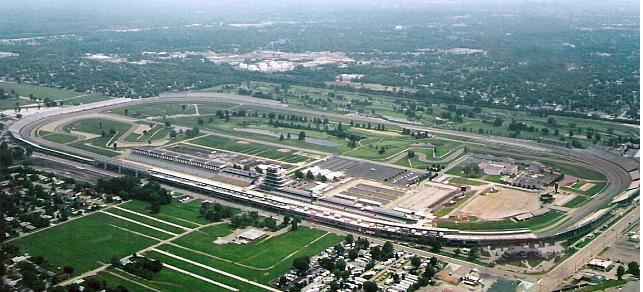Monday, May 25, 2015
 When I am flying home to Indianapolis, I always hope for the landing pattern that takes us over the famed oval of the Indianapolis Motor Speedway. The image here gives you an idea – but unless you have seen it for yourself, you have no grasp for it. The track is 2.5 miles around. Think about that in your daily driving patterns and you have a sense for the size of the complex.
When I am flying home to Indianapolis, I always hope for the landing pattern that takes us over the famed oval of the Indianapolis Motor Speedway. The image here gives you an idea – but unless you have seen it for yourself, you have no grasp for it. The track is 2.5 miles around. Think about that in your daily driving patterns and you have a sense for the size of the complex.
This is truly a big picture view of the Indianapolis Motor Speedway.
I write this before the 99th running of the Indy 500 this Sunday, and while I won’t be in attendance, I have attended several times. Each time I have sat in a different location, and I have even been right beside the track (as a member of the Purdue All American Marching Band) before the start of the race when the famous call “Ladies and Gentlemen, start your engines!” is given. Each of these provides a different viewpoint of the facility and the race.
Stating it more directly, everyone at this weekend’s race had a different experience of the race in part because of where they sat and what they could see. This is exactly what happens in our workplaces every day.
Everyone comes to work to do their job, and in most all cases, people are there wanting to do their best work and trying to do so based on where they sit and what they can see. And they can’t operate beyond what they can see.
Car drivers have spotters high above the track to give them input and to help them “see” what they can’t see themselves. Why is this important? When they have the bigger perspective, they can be more effective, safer and hopefully more successful as a driver.
Again, so too for us at work every day.
As a leader, it is our job to be the spotter for our team member; to help people see the full, big picture.
And this all seems well and good and makes some sense, but in the real world of work, many people just want to know what they are supposed to do. They say things like:
- “Just tell me what to do.”
- “What is the task list?”
- “Can you give me a checklist?”
And, while it is fine that they want these things, as a leader, we know we want them to have the bird’s-eye-view of the work too – understanding how what they do connects to the larger picture of the organization’s goals and success.
There is our dilemma – people ask for one thing, and we need to provide that, but we know they need something more than that. Here are five ways to give them that needed perspective, even when they aren’t asking for it.
Share the big picture regularly. If you have team meetings, are you talking about the organization’s objectives and purpose regularly? If you make the big picture a consistent part of your message, it will be understood – an organically created piece of knowledge. When this occurs, the rest of these ideas become easier to do.
Give the details first, then add the context. If you try to give them the big picture first you may frustrate them, so don’t do it. If the person has asked for the details, the steps and the granularity of their role or task, give it to them. Then continue by telling people the big picture too. If they hear the big picture message, you have improved their perspective and understanding – and most importantly, helped them better understand the tasks they are being asked to do.
Ask them what they see. Helping people see something new needs to include finding out what they already see. In other words, questions can be powerful here. Examples:
- How does this task fit into the overall goals for the team?
- What are the most important components of doing this work successfully?
You might find they do understand the big picture, that they have a faulty perspective, or have no clue at all. Questions like these will help you create awareness and understanding in others – and set the stage for the last two suggestions.
Connect the big picture to their work. Often the big disconnect isn’t knowing the work or even knowing the big picture. Often the gap is that people don’t see how those two go together. As leaders, we assume that once they see the big picture, they see how it is relevant to them.
That is a bad assumption.
Once people understand the aerial view, help them see how their work is an integral part of the whole.
Connect the big picture to meaning. In the end, this is the most important of all. People want to do work that has a purpose and a meaning. People want to make a difference. One of the best ways to help people get that sense is to help them see what the organization is about and where it is headed. Those aspirations are usually inspiring and filled with meaning. Give your team members a sense of meaning in their work and you will be doing some of the most important work you could ever do.
These five things will allow you to be a spotter for your teams – to help them see a bit bigger, to think more strategically and to do their work with the big picture and end goal in mind.